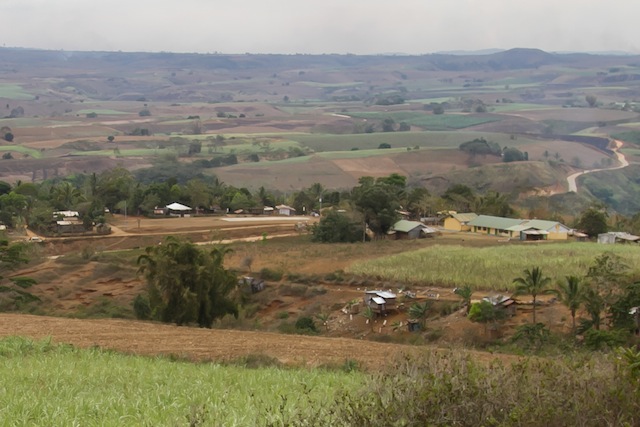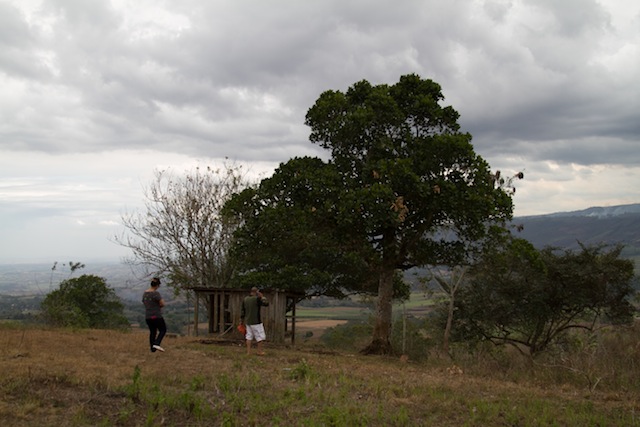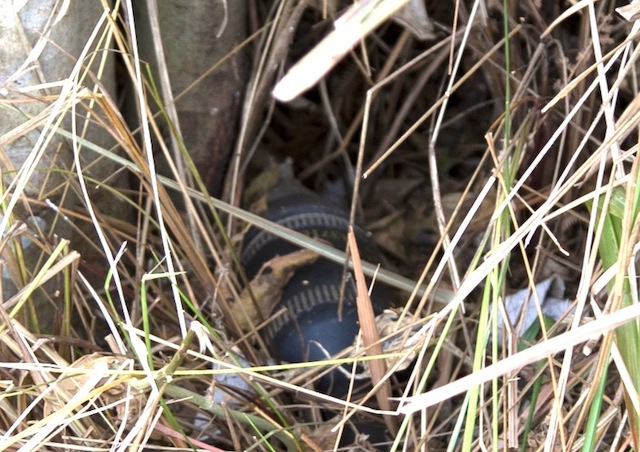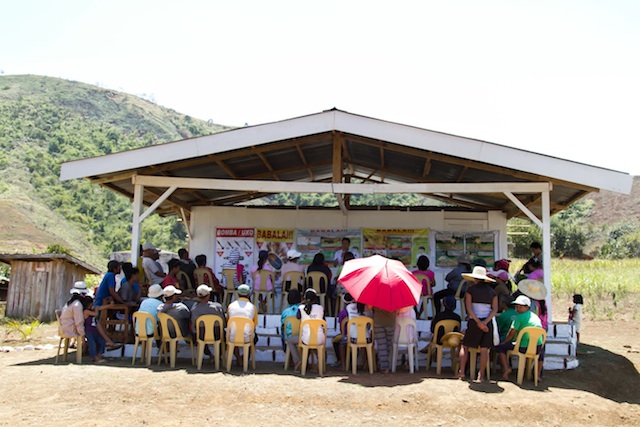(Author’s disclaimer: This is not an official report. This is a written account of what I heard and saw).
A small community of settlers in the 1950s resides in Sitio Kibaritan. The sitio is located on top of a small hill in Barangay Malinao, Municipality of Kalilangan in Bukidnon province. Across the sitio is the more famous hill in the munipicality, Pudong hill. As residents put it, they come from an unknown place until an explosion changed the lives of the residents of the small community.
This news brought me to that place: http://www.gmanetwork.com/news/story/560682/news/regions/3-killed-one-injured-in-bukidnon-explosion
I went there with the Philippine Campaign to Ban Landmines-Fondacion Suisse de Deminage (PCBL-FSD) team based in Cotabato City.
 PUDONG HILL. The view from Pudong hill; the Kibaritan Elementary School at the foot of the hill and the sitio across. Photo courtesy of FRED LUBANG / PCBL-FSD
PUDONG HILL. The view from Pudong hill; the Kibaritan Elementary School at the foot of the hill and the sitio across. Photo courtesy of FRED LUBANG / PCBL-FSD
PCBL-FSD
On April 5, 2016 around 3 p.m., we went to Kalilangan Elementary School so we can meet the District Supervisor of Kalilangan District and the School Head and a teacher from Kibaritan Elementary School.
The District Supervisor Ma’am Susana Egar, School Head Gemma Ebcas and Teacher Sherryl Anne Matandac accompanied us to Sitio Kibaritan to see the two survivors of the blast and to meet their families.
We briefly introduced ourselves, why we were there and then the teachers invited us to proceed to the sitio. In the car, Ma’am Susana asked, “When the military test-fire their weapons and explosives, I did not know that they do not get back the ones that don’t work.”
Teacher Sherryl Anne is a local of Sitio Kibaritan, she guided us through the sitio and introduced me to Marife Copreros Waminal, the mother of Roldmar, Delmar and Reggie. She didn’t say much, only to correct the spelling of the names of her children on my notebook. She left us briefly to look for her son Roldmar so he can to talk to us about the tragic incident.
Her husband, Rodel, arrived at their residence shortly after she left. He spoke about the incident in Visayan and Filipino. Even though I didn’t understand, I knew there was anger in his voice and resentment in his words. I only a caught the few words he spoke in Filipino, “Ang sabi ng militar, bobo ang mga tao dito dahil umaakyat kami doon. Kami pa ngayon ang bobo?!”
Rodel said that the military extended some financial help. When we asked around, we were told the total amount extended to the families amounted to 25,000 pesos.
Home for residents, firing range for military
We found out during the exchanges that the residents of Sitio Kibaritan is in a legal battle with the military over the right to stay in the land they have cultivated and farmed for the last 57 years. They used to rent from the military, then the rent stopped when the case started. No decision has been made; the residents consider the area as their home while the military consider it as their firing range.
Roldmar came back around this time. I left the group talking to Rodel and went to talk to Roldmar. He only spoke in Visayan and Ma’am Susana offered to translate for us.
According to Roldmar, he, along with his brothers Reggie, 11, and Delmar, 15, their cousin Lloyd Pasague, 13 and their friend Mark Lawrence Cadiz, 16 found a “mortar na walay ikog” (mortar without a tail fin) on their way up Pudong hill. It was Good Friday, they were doing their penitence through climbing the hill and reaching the Cross on the top like everyone else.
Roldmar said they moved the “mortar” near a tree and a small abandoned hut on the smaller hill beside Pudong and returned to it on their way back.
 BLAST SITE. Kagawad Amar guides us to the site of the blast. Photo courtesy of FRED LUBANG / PCBL-FSD
BLAST SITE. Kagawad Amar guides us to the site of the blast. Photo courtesy of FRED LUBANG / PCBL-FSD
Roldmar’s brother Delmar was the bold one who tried to smash the explosive on the ground three times but it didn’t explode. Then, as Roldmar narrated, when they left it alone that was when it exploded killing Reggie instantly and disintegrating the body of Delmar beyond recognition.
Roldmar said he was doing pull ups by the old hut and was only hit by shrapnel on his right leg. His friend Mark Lawrence was also there but was physically unharmed.
Another boy came to the Waminal’s residence, Mark Lawrence Cadiz, one of the two survivors of the blast joined us.
Spared, shocked
Mark Lawrence narrated in Filipino how his friends hit the explosive four times before he heard the explosion. He was spared because his friends told him he will have no part in the loot when they sell the metal, and after being told that, he turned his back and walked towards the back of the old hut where he sat quietly before being thrown off by the sound of the blast. He was behind the hut and a jackfruit tree when he heard the blast that shook the ground and threw him off the slope of the small hill.
When he finally got back up to see what had happened, the bodies of his friends shocked him. He was paralyzed by what he saw and did not speak to anyone for several days.
Mark Lawrence had a bruise when I met him. His mother told me, in Visayan and Ma’am Susana translated, that his father hit him because he thought his son played with the explosive that killed the three children. It was only after the police informed them that had he been the one playing with the explosive he would have ended up like Delmar that they believed him that he didn’t touch the thing that killed his friends. He only answered questions briefly. Like Roldmar, he hardly looked anyone in the eye when he spoke.
People started to gather around us at the residence. Everyone in the community recounted the events through their own experiences that day.
Barangay Kagawad Manolito Amar who resides in Sitio Kibaritan and was one of the first responders to the scene came around the Waminal residence. He also introduced Sitio Leader Esteban Rafania.
Kagawad Amar said they heard the explosion at 1:45 p.m. The ground shook from where they stood. They went up the hill and saw the aftermath. He called the police immediately and rushed Lloyd to the government hospital in Kalilangan, fifteen minutes away from Sitio Kibaritan. Unfortunately, Lloyd died in the hospital.
Picking up pieces
Sitio Leader Rafania told me that Rodel, the father of Delmar, Reggie and Roldmar, picked up pieces of his sons in a 25ft radius. He said Rodel combed through the grass and soil for his sons’ body parts, intestines and all, so he can bury his sons properly. Rodel put what was left – pieces of Delmar’s body – of his son in a sack and didn’t talk to anyone.
Sitio Leader Rafania and Kagawad Amar told me that if Good Friday did not come, maybe this would not have happened.
I looked up to the hill – it was calm, green and very inviting, I remembered the time when I was a kid looking for adventures and hidden treasures – I would have climbed that hill, Good Friday or not.
I told the men that it would have still happened, maybe not to these children, but this was an accident that will happen because there were explosives lying around waiting to claim its victims. The children didn’t stand a chance.
Morning of April 5, I met police officer Charlie Pajo Nemeño, the acting-chief-of-police of Kalilangan. He said on March 25, 2016 at 2:09 p.m. they received a message from the Kagawad about an explosion and that victims needed help. They rushed to Pudong hill, sending the police car racing through the rough road and arrived 15 minutes after they received the report. There were no more survivors there.
They gathered statements and took pictures. The blast created a 64-inch deep crater in the ground. They believed the unexploded ordnance (UXO) that the children found was a 90mm high explosive anti-tank. They are still waiting for the result from the crime lab.
I could not get myself to open the picture files that the police gave us, I only took a picture from my phone from their printed report.
“Now I know”
I asked him if he had received previous reports of any explosions, damages to property or livestock, he said there have been no reports at all. I asked him if he knew there were explosives left in the area, and he replied “now I know”.
At around 2 p.m. that day, I went up to Pudong hill guided by Kagawad Amar and Sitio Leader Rafania along with the PCBL-FSD team.
It was cool and breezy. I thought the hill was the perfect playground. Up the hill, I saw the elementary school was just below and the sitio across. You can climb the hill through the school grounds.
I asked the two men about the history of Sitio Kibaritan and how they came to that place. It turns out that Sitio Leader Rafania’s father was one of the first settlers in the place. He was a retired soldier and moved there in 1959. They knew it was a military reserve with 40.000 hectares of farmland; they rented a few hectares from the military. Other retired soldiers started arriving, their families joined and the farming community grew. The empty military reserve where they now reside became known as Sitio Kibaritan.
He said they first heard the gunfire in 2006, he said that was when the hill became a practice range for guns. It was also the year that the “military camp” was built below the community.
Then the gunfire became louder in the years that came, and around 2008 was when they knew the military was using “armalite”. And in 2010 the gunfire became blasts; the community knew then they were using “mortar”.
On the hill, Kagawad Amar told us that before, there were no signs that this was a danger zone. He went back there the day after the tragedy, on March 26 together with the police to put up the signs and cordon the area where the residents told them there was another “mortar”. They found two — one an 81mm mortar ammunition and the other a 90mm high explosive anti-tank.
 One of the UXOs, a 90mm high explosive anti-tank that is still in the field, waiting to be cleared. Photo courtesy of FRED LUBANG / PCBL-FSD
One of the UXOs, a 90mm high explosive anti-tank that is still in the field, waiting to be cleared. Photo courtesy of FRED LUBANG / PCBL-FSD
They informed the military about this, especially the Explosives Ordnance Division, and requested that they clear the area. I asked him if he had an idea when these were left behind. He said he couldn’t say exactly but it was around the time that a military battalion arrived and left hurriedly.
The next morning, before the PCBL-FSD team conducted a Mines/UXO Risk Education in the school among the community members, we went to meet with the camp officer-in-charge of the training facility. There, I met Major Wilson Abdurasad. I asked him if he knew that there were explosives left behind, he said “I had no idea they left them behind, I was only tending to the coffee”.
I thought I misheard him and asked again, he repeated, “I am in charge of the coffee”.
After seeing the reaction from our faces, he later explained that there is an existing project between the DND and Nestle. His camp takes care of over 81,000 coffee seedlings.
The infantry battalion that fired M203s during their retraining did not inform him about leaving behind anything – they just left when it was time to go – so he went back to running their coffee nursery.
After that meeting, we all proceeded to the Kibaritan Elementary School to give the residents and the children at the school mine risk education training. The atmosphere was tense. Residents did not look too happy when they saw the military. Everyone was quiet.
 Residents of Sitio Kibaritan attend the Mine Risk Education training conducted by the PCBL-FSD team. FRED LUBANG / PCBL-FSD
Residents of Sitio Kibaritan attend the Mine Risk Education training conducted by the PCBL-FSD team. FRED LUBANG / PCBL-FSD
There were two MRE sessions, one for the adults and one for the children. During this time, I got to talk to one of the teachers of the school. She told me the school was built in 1984. There are only four teachers in the school.
Standing from inside the classroom, I could see the view of the hill. The classrooms were just at the foot of Pudong hill. It was so close. The teacher told me they warn the children not go up the hill. I asked what if they miss during artillery practice and they hit the school instead of the hill, the teacher whose name I was not able to get replied, “It hasn’t happened”.
The school has 101 students.
(Written in memory of Delmar, Lloyd, and Reggie. Mitzi Austero is the Programmes Manager of Building Peace by Teaching Peace which has a running peace education program in Bangsamoro and Southern Thailand provinces. She has been living in Cotabato City since 2012)
